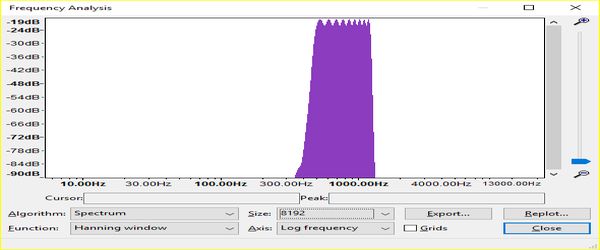Audio: chirp (0:02)

chirp plays three sounds in succession: a 440Hz sine wave, a 1320Hz sine wave, and a chirp from 440Hz to 1320Hz. The chirp figure shows the spectrogram of the chirp.
A chirp is a glissando, a gliding, sweeping sound from one pitch to another.
chirp is a digital sound effect created by synthesis and some computer programmes and apps have a built-in feature to generate a chirp. This chapter looks at two interesting features of a chirp: how it is generated and whether it is pitched or unpitched sound. The answers will tell us a lot about how digital sound effects are created and used.
The actual process of producing a digital chirp is done by an oscillator.
An oscillator is widely used in digital music and in science and engineering. In music, an oscillator does two things: it generates sound and it controls sound.
The first use of an oscillator is to generate digital audio. An oscillator acting as a sound generator was used to create the sound of the sine, saw, triangle, pulse and square waves in the guide. Another oscillator was used to generate the sounds of white, pink and red noise. An oscillator functioning as a sound generator is a synth or a digital instrument and it does not matter whether we call the sound generator an oscillator, a synth or a digital instrument, its purpose is the same, to generate sound
The second use of an oscillator is to control sound. The sole purpose of this type of oscillator is to control the frequency, amplitude or phase of another sound.
Many oscillators are dual-purpose and can function as either a sound generator or a sound controller. A single oscillator, however, can only perform one function at a time. For example, a sine wave oscillator can generate digital audio. That same sine wave oscillator cannot function at the same time as a controller. But another sine wave oscillator can. Two similar oscillators can perform separate functions, one acting as a sound generator and the other acting as a sound controller.
The key feature in writing sound effects is that it requires a minimum of two oscillators, one to generate sound, another to control it. chirp uses two such oscillators. One, the sound generator, creates a sine wave, the other, the sound controller, continuously changes the frequency of that sine wave. All digital sound effects require at least two oscillators, and sometimes many more.
An oscillator acting as a sound controller significantly extends the boundaries of music. A sound no longer has to have a fixed frequency, it can use a control oscillator to produce a variable frequency. The same goes for amplitude and phase, they too can be varied by a control oscillator. Complete pieces of music can be written using oscillators to control the sound of other oscillators generating sound.
The other interesting feature of chirp is whether it is a melody or a noise. In a chirp, the pitch at a single point in time is fixed, and a slow chirp could be considered as a melody consisting of a succession of notes. Alternatively, the pitch in a fast chirp can vary so quickly that the perception is of a single unpitched sound, noise in other words. There is no right or wrong answer to the question, a chirp can be considered as either a melody or a noise. Sound effects such as chirp blur the boundary between pitched and unpitched sound.